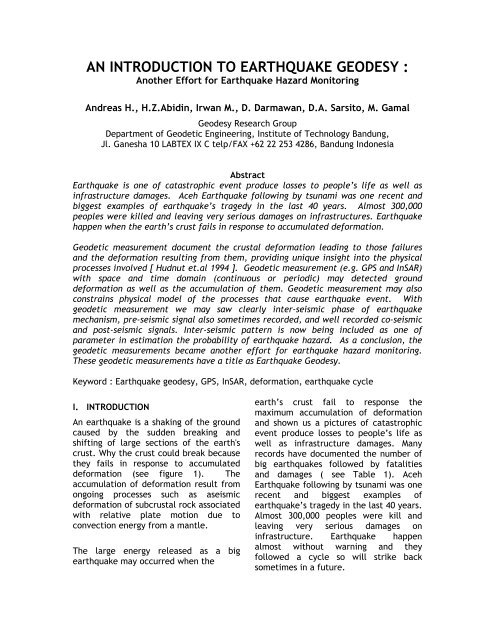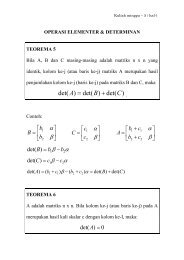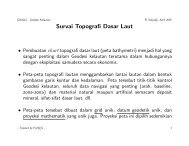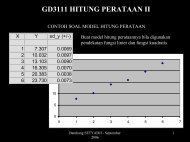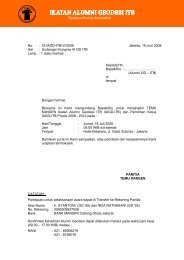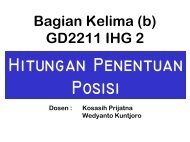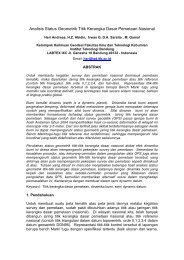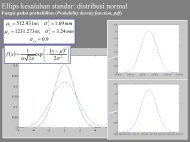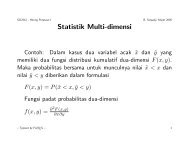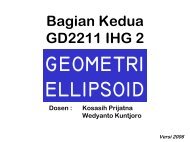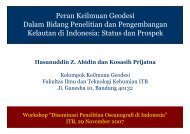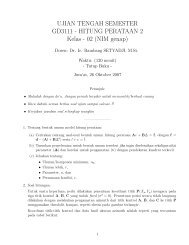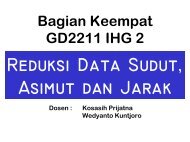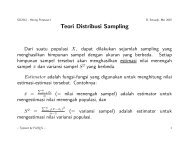an introduction to earthquake geodesy
an introduction to earthquake geodesy
an introduction to earthquake geodesy
Create successful ePaper yourself
Turn your PDF publications into a flip-book with our unique Google optimized e-Paper software.
AN INTRODUCTION TO EARTHQUAKE GEODESY :<br />
Another Effort for Earthquake Hazard Moni<strong>to</strong>ring<br />
Andreas H., H.Z.Abidin, Irw<strong>an</strong> M., D. Darmaw<strong>an</strong>, D.A. Sarsi<strong>to</strong>, M. Gamal<br />
Geodesy Research Group<br />
Department of Geodetic Engineering, Institute of Technology B<strong>an</strong>dung,<br />
Jl. G<strong>an</strong>esha 10 LABTEX IX C telp/FAX +62 22 253 4286, B<strong>an</strong>dung Indonesia<br />
Abstract<br />
Earthquake is one of catastrophic event produce losses <strong>to</strong> people’s life as well as<br />
infrastructure damages. Aceh Earthquake following by tsunami was one recent <strong>an</strong>d<br />
biggest examples of <strong>earthquake</strong>’s tragedy in the last 40 years. Almost 300,000<br />
peoples were killed <strong>an</strong>d leaving very serious damages on infrastructures. Earthquake<br />
happen when the earth’s crust fails in response <strong>to</strong> accumulated deformation.<br />
Geodetic measurement document the crustal deformation leading <strong>to</strong> those failures<br />
<strong>an</strong>d the deformation resulting from them, providing unique insight in<strong>to</strong> the physical<br />
processes involved [ Hudnut et.al 1994 ]. Geodetic measurement (e.g. GPS <strong>an</strong>d InSAR)<br />
with space <strong>an</strong>d time domain (continuous or periodic) may detected ground<br />
deformation as well as the accumulation of them. Geodetic measurement may also<br />
constrains physical model of the processes that cause <strong>earthquake</strong> event. With<br />
geodetic measurement we may saw clearly inter-seismic phase of <strong>earthquake</strong><br />
mech<strong>an</strong>ism, pre-seismic signal also sometimes recorded, <strong>an</strong>d well recorded co-seismic<br />
<strong>an</strong>d post-seismic signals. Inter-seismic pattern is now being included as one of<br />
parameter in estimation the probability of <strong>earthquake</strong> hazard. As a conclusion, the<br />
geodetic measurements became <strong>an</strong>other effort for <strong>earthquake</strong> hazard moni<strong>to</strong>ring.<br />
These geodetic measurements have a title as Earthquake Geodesy.<br />
Keyword : Earthquake <strong>geodesy</strong>, GPS, InSAR, deformation, <strong>earthquake</strong> cycle<br />
I. INTRODUCTION<br />
An <strong>earthquake</strong> is a shaking of the ground<br />
caused by the sudden breaking <strong>an</strong>d<br />
shifting of large sections of the earth's<br />
crust. Why the crust could break because<br />
they fails in response <strong>to</strong> accumulated<br />
deformation (see figure 1). The<br />
accumulation of deformation result from<br />
ongoing processes such as aseismic<br />
deformation of subcrustal rock associated<br />
with relative plate motion due <strong>to</strong><br />
convection energy from a m<strong>an</strong>tle.<br />
The large energy released as a big<br />
<strong>earthquake</strong> may occurred when the<br />
earth’s crust fail <strong>to</strong> response the<br />
maximum accumulation of deformation<br />
<strong>an</strong>d shown us a pictures of catastrophic<br />
event produce losses <strong>to</strong> people’s life as<br />
well as infrastructure damages. M<strong>an</strong>y<br />
records have documented the number of<br />
big <strong>earthquake</strong>s followed by fatalities<br />
<strong>an</strong>d damages ( see Table 1). Aceh<br />
Earthquake following by tsunami was one<br />
recent <strong>an</strong>d biggest examples of<br />
<strong>earthquake</strong>’s tragedy in the last 40 years.<br />
Almost 300,000 peoples were kill <strong>an</strong>d<br />
leaving very serious damages on<br />
infrastructure. Earthquake happen<br />
almost without warning <strong>an</strong>d they<br />
followed a cycle so will strike back<br />
sometimes in a future.
Figure 1. Illustration of accumulation of deformation leading <strong>to</strong> failure respond of the earth’s<br />
crust when it c<strong>an</strong> no longer resisted <strong>to</strong> the accumulated energy from ongoing processes such as<br />
aseismic deformation of subcrustal rock associated with relative plate motion due <strong>to</strong> convection<br />
energy from a m<strong>an</strong>tle, produce <strong>an</strong> <strong>earthquake</strong> <strong>an</strong>d sometimes followed by tsunami. Image with<br />
courtesy of J. Mori on KAGI lecture’s note. [Mori 2004 ]<br />
Table 1<br />
Record examples of big Earthquakes (sometimes followed by tsunami) leaved notes of terrible<br />
numbers of fatalities ( Mori 2004);( Vigny 2005 )<br />
no Earthquakes event Fatalities<br />
1 Earthquake in Lisbon Portugal followed by 70.000 peoples were killed<br />
tsunami on November 1, 1755<br />
2 Earthquake in Tokyo Jap<strong>an</strong> ( 7.9 Mw )<br />
99.331 peoples were killed<br />
on September 1, 1923<br />
3 Earthquake in S<strong>an</strong>riku Jap<strong>an</strong><br />
3.064 peoples were killed<br />
on March 3, 1933<br />
4 Earthquake in Fukui Jap<strong>an</strong><br />
3.769 peoples were killed<br />
on June 48, 1948<br />
5 Earthquake in Th<strong>an</strong>gs<strong>an</strong> China ( 7.8 Mw ) 240.000 peoples were killed<br />
on July 28, 1976<br />
6 Earthquake in Armenia on year 1988 25.000 peoples were killed<br />
7 Earthquake in Ir<strong>an</strong> on year 1990 40.000 peoples were killed<br />
8 Earthquake in Kobe Jap<strong>an</strong> ( 6.9 Mw )<br />
5096 peoples were killed<br />
on J<strong>an</strong>uary 17, 1995<br />
9 Earthquake in Aceh Sumatr<strong>an</strong> subduction zone<br />
( Mw 9.0 ) followed by tsunami on December<br />
26, 2004<br />
Almost 300.000 peoples were<br />
killed<br />
Records of such big event has proven that<br />
a single <strong>earthquake</strong> c<strong>an</strong> cause thous<strong>an</strong>ds<br />
of deaths <strong>an</strong>d not <strong>to</strong> mention thous<strong>an</strong>ds<br />
others became injured. Although<br />
<strong>earthquake</strong>s are uncontrollable, the<br />
losses they cause c<strong>an</strong> be reduced by<br />
develop <strong>earthquake</strong> hazard moni<strong>to</strong>ring<br />
<strong>an</strong>d mitigation programs (e.g. conducting<br />
m<strong>an</strong>y researches <strong>to</strong> <strong>an</strong>alyzed <strong>earthquake</strong><br />
mech<strong>an</strong>ism, matching l<strong>an</strong>d use <strong>to</strong> risk,<br />
building structures that resist <strong>earthquake</strong><br />
damage, developing emergency response<br />
pl<strong>an</strong>s, <strong>an</strong>d other me<strong>an</strong>s). As a result of<br />
technologies, in the early years ninety<br />
has been introduced <strong>an</strong>other <strong>to</strong>ols for<br />
<strong>earthquake</strong> hazard moni<strong>to</strong>ring namely<br />
<strong>earthquake</strong> <strong>geodesy</strong> which will be<br />
explained more in this paper.
II. SEQUENCE AND MECHANISM OF THE<br />
EARTHQUAKE<br />
Until <strong>to</strong>day, the m<strong>an</strong>tle convection still<br />
believed as <strong>an</strong> appropriated theory <strong>to</strong><br />
explain the movement of the plates <strong>an</strong>d<br />
the source mech<strong>an</strong>ism of the <strong>earthquake</strong>.<br />
The energy from convection steering the<br />
plate <strong>to</strong> move one <strong>an</strong>other. One block of<br />
plates <strong>an</strong>d the others would converge,<br />
diverge, or move side by side. At the<br />
plates interface where two plates merge<br />
<strong>an</strong>d locked by friction, then this earth’s<br />
crust area will experienced a<br />
deformation. As the energy from the<br />
m<strong>an</strong>tel will continuously forced the<br />
plates <strong>to</strong> move consistently, a<br />
consequences the deformation in the<br />
plates interface will increasingly<br />
accumulated. Within few ten years <strong>to</strong><br />
hundred years when the accumulation of<br />
deformation reached maximum stage,<br />
this earth’s crust may fails in response <strong>to</strong><br />
those accumulated deformation <strong>an</strong>d<br />
produce the sudden breaking <strong>an</strong>d shifting<br />
of large sections of the earth's crust,<br />
making the ground <strong>to</strong> shake <strong>an</strong>d its called<br />
<strong>earthquake</strong>.<br />
For a moments, the energy was released<br />
by the <strong>earthquake</strong> ( mainshock <strong>an</strong>d<br />
aftershock), made the deformation<br />
return <strong>to</strong> zero. The <strong>earthquake</strong> has<br />
unlock the friction. But after few months<br />
<strong>to</strong> few years when this dynamic earth has<br />
return <strong>to</strong> equilibrium stage, the plates<br />
interface will experienced new<br />
deformation. Again, the merged plates<br />
could lock by the friction <strong>an</strong>d the<br />
deformation will beginning <strong>to</strong><br />
accumulated leading <strong>to</strong> failure respond<br />
of this earth’s crust producing new<br />
<strong>earthquake</strong>. This sequence called<br />
<strong>earthquake</strong> cycles. In detail the<br />
<strong>earthquake</strong> cycles divided in<strong>to</strong> interseismic,<br />
co-seismic, <strong>an</strong>d post-seismic<br />
sequence. Pre-seismic is now still being<br />
<strong>an</strong>alyzed before officially included as<br />
part of all sequence.<br />
inter-seismic<br />
At the inter-seismic sequence, the two<br />
plates interface is locked by friction. The<br />
upper plate is accumulating elastic<br />
deformation at a slow rate (~1cm/yr).<br />
This loading phase c<strong>an</strong> last for centuries<br />
Co-seismic<br />
The <strong>earthquake</strong> releases in one moment<br />
deformation accumulated for centuries.<br />
At that stage, the upper plate<br />
“rebounds”. In the subduction zone, the<br />
whole system being below sea level, this<br />
gi<strong>an</strong>t “kick” in sea water generates a<br />
Tsunami<br />
Post-seismic<br />
Return <strong>to</strong> equilibrium <strong>an</strong>d steady loading<br />
c<strong>an</strong> take years.<br />
Figure 2. Illustration of <strong>earthquake</strong> cycle in<br />
subduction zone ( Vigny et.al 2005 )
III. GEODETIC DATA AND EARTHQUAKE<br />
STUDIES ( EARTHQUAKE GEODESY )<br />
As mention previously, <strong>earthquake</strong><br />
happen when the earth’s crust fails in<br />
response <strong>to</strong> accumulated deformation.<br />
Geodetic measurement document the<br />
crustal deformation leading <strong>to</strong> these<br />
failures <strong>an</strong>d the deformation resulting<br />
from them, providing unique insight in<strong>to</strong><br />
the physical processes involved [ Hudnut<br />
et.al 1994 ]. Geodetic measurement<br />
with space <strong>an</strong>d time domain (continuous<br />
or periodic) may detected ground<br />
deformation as well as the accumulation<br />
of them. Geodetic measurement may<br />
also constrains physical model of the<br />
processes that cause <strong>earthquake</strong> event.<br />
With geodetic measurement we may saw<br />
clearly inter-seismic phase of <strong>earthquake</strong><br />
mech<strong>an</strong>ism, pre-seismic signal also<br />
sometimes recorded, <strong>an</strong>d well recorded<br />
co-seismic <strong>an</strong>d post-seismic signals.<br />
Adv<strong>an</strong>ces in Global Positioning System (<br />
GPS ) measurement <strong>an</strong>d data <strong>an</strong>alysis<br />
technology, <strong>an</strong>d the increasing number<br />
<strong>an</strong>d improving quality of GPS receivers<br />
deployed in active tec<strong>to</strong>nic area, plus the<br />
occurrence of <strong>an</strong>other most exciting new<br />
development Interferometric Syntetic<br />
Aperture Radar (InSAR), have contributed<br />
steadily <strong>to</strong>wards underst<strong>an</strong>ding<br />
<strong>earthquake</strong> sources <strong>an</strong>d inter-seismic<br />
deformation, <strong>an</strong>d hence <strong>to</strong>ward<br />
improving hazard evaluation. Interseismic<br />
pattern is now being included as<br />
one of parameter in estimation the<br />
probability of <strong>earthquake</strong> hazard. As a<br />
conclusion, the geodetic measurements<br />
became <strong>an</strong>other effort for <strong>earthquake</strong><br />
hazard moni<strong>to</strong>ring. These geodetic<br />
measurements have a title as Earthquake<br />
Geodesy.<br />
technique we have for identifying the<br />
location of future <strong>earthquake</strong>s in some<br />
areas, because elastic rebound requires<br />
elastic strain accumulation prior <strong>to</strong><br />
<strong>earthquake</strong>s. With geodetic measurement<br />
we may saw clearly inter-seismic phase<br />
of <strong>earthquake</strong> mech<strong>an</strong>ism <strong>an</strong>d also give<br />
the better constrain <strong>to</strong> the location of<br />
predicted future <strong>earthquake</strong>.<br />
M<strong>an</strong>y of the early studies of inter-seismic<br />
deformation using geodetic data ( GPS )<br />
<strong>to</strong>ok place in southern California. These<br />
studies were also instrumental in<br />
developing geodetic GPS methods <strong>an</strong>d in<br />
characterizing the precision <strong>an</strong>d accuracy<br />
of the technique (e.g. Larson & Agnew<br />
1991; Feigl et al 1993). Feigl et al (1993)<br />
presented a comprehensive review of<br />
GPS data collected in central <strong>an</strong>d<br />
southern California between 1986 <strong>an</strong>d<br />
1992, as well as VLBI data collected<br />
between 1984 <strong>an</strong>d 1991. They also<br />
discussed methods for obtaining <strong>an</strong>d<br />
combining highly precise GPS solutions<br />
for the determination of station<br />
velocities in regional-scale networks.<br />
Daily solutions with phase ambiguities<br />
fixed <strong>to</strong> integers (where possible) were<br />
estimated with very loose constraints on<br />
the station coordinates.<br />
III.1 Geodetic Data <strong>an</strong>d Inter-seismic<br />
Deformation<br />
Detection of slow inter-seismic strain<br />
accumulation is probably the best<br />
Figure 3. Inter-seismic deformation along the<br />
coast of California. Image with courtesy of<br />
Prof Thomas Herring. [Herring 2002]
III.2 Geodetic Data <strong>an</strong>d Pre-seismic<br />
Deformation<br />
Just a few days before Ton<strong>an</strong>gkai<br />
<strong>earthquake</strong> happen in December 1944,<br />
spirit leveling result has shown preseismic<br />
deformation signals (mogi 1984).<br />
The tilt start <strong>to</strong> ch<strong>an</strong>ging four day before<br />
the mainshock. This was the amazing<br />
discovery that the <strong>earthquake</strong> tell us<br />
something before they coming. With this<br />
precursor then the scientist though the<br />
<strong>earthquake</strong> may be known before <strong>an</strong>d<br />
would give the early warning. But this<br />
signal turn out <strong>to</strong> be the one <strong>an</strong>d the only<br />
best signal it ever have. M<strong>an</strong>y years<br />
come, the <strong>earthquake</strong>s happen with<br />
given no pre-seismic signal at all.<br />
Figure 4. spirit leveling result has shown preseismic<br />
deformation signals three <strong>to</strong> four<br />
days before the mainshock exist (mogi 1984).<br />
In the GPS era, in Arequipa Peru, preseismic<br />
deformation signal has occurred<br />
before the mainshock come. Position in<br />
daily solutions start <strong>to</strong> give <strong>an</strong> <strong>an</strong>omalies<br />
result in few months <strong>to</strong> a few days before<br />
the mainshock happen. But again in m<strong>an</strong>y<br />
well recorded continuous GPS signal in a<br />
period of <strong>earthquake</strong> there are currently<br />
more negative result then positive result<br />
in pre-seismic deformation signals. Preseismic<br />
deformation signal is now still<br />
being <strong>an</strong>alyzed whether its just <strong>an</strong><br />
<strong>an</strong>omaly signal in some case of<br />
<strong>earthquake</strong> or we may saw well in <strong>an</strong>y<br />
certain characteristics of plates<br />
interface.<br />
III.3 Geodetic Data <strong>an</strong>d Co-seismic<br />
Deformation<br />
Adv<strong>an</strong>ces in Global Positioning System (<br />
GPS ) measurement <strong>an</strong>d data <strong>an</strong>alysis<br />
technology, <strong>an</strong>d the increasing number<br />
<strong>an</strong>d improving quality of GPS receivers<br />
deployed in active tec<strong>to</strong>nic area, plus the<br />
occurrence of InSAR Technology has<br />
achieved m<strong>an</strong>y well recorded co-seismic<br />
deformations (e.g. Figure 5-6). GPS<br />
measurements c<strong>an</strong> be related <strong>to</strong> the<br />
<strong>earthquake</strong> source process through<br />
Volterra’s formula (e.g. Aki & Richards<br />
1980) for displacement at the Earth’s<br />
surface due <strong>to</strong> slip on a surface of<br />
displacement discontinuity in <strong>an</strong> elastic<br />
medium. GPS measurements of surface<br />
displacement c<strong>an</strong> thus be inverted <strong>to</strong><br />
determine the geometry of <strong>earthquake</strong><br />
rupture(s). This determination is<br />
particularly import<strong>an</strong>t for <strong>earthquake</strong>s<br />
that do not rupture the ground surface,<br />
or when seismic data, including<br />
aftershock distributions, do not clearly<br />
determine the rupture geometry.<br />
In estimating the source geometry, <strong>an</strong><br />
<strong>earthquake</strong> is typically represented by<br />
one or more rect<strong>an</strong>gular dislocations with<br />
spatially uniform slip. Once the fault<br />
geometry is known, it is possible <strong>to</strong><br />
determine the distribution of slip on the<br />
fault surface, <strong>an</strong>d further on it help us<br />
for better underst<strong>an</strong>ding the co-seismic<br />
mech<strong>an</strong>ism <strong>an</strong>d the stress tr<strong>an</strong>sfer<br />
mech<strong>an</strong>ism concerning the evaluation <strong>to</strong><br />
next <strong>earthquake</strong> potential occurrence<br />
<strong>an</strong>d the constrain of predicted area of<br />
future <strong>earthquake</strong>.<br />
Below given some examples of co-seismic<br />
captures in some areas suffering the<br />
<strong>earthquake</strong> (e.g. Kurile isl<strong>an</strong>d 1994, Aceh<br />
2004, <strong>an</strong>d Chi-chi Earthquake 1999 )
III.4 Geodetic Data <strong>an</strong>d Post-seismic<br />
Deformation<br />
Figure 5. Horizontal displacement vec<strong>to</strong>rs<br />
from the M8.1 Kurile Isl<strong>an</strong>ds (Hokkaido-Toho-<br />
Oki), Jap<strong>an</strong>, <strong>earthquake</strong>, Oc<strong>to</strong>ber 4, 1994.<br />
Displacements are relative <strong>to</strong> a station 1100<br />
km away. Error ellipses show 99% confidence<br />
regions. After Tsuji et al (1995).<br />
Figure 6. Co-Seismic from the M9.0 Mega<br />
thrust <strong>earthquake</strong> Aceh, December 26, 2004.<br />
More then 2 meter displacements occurred in<br />
city of B<strong>an</strong>da Aceh. Irw<strong>an</strong> et al (2005).<br />
Figure 7. Average co-seismic deformation<br />
interferogram from Chi-chi <strong>earthquake</strong> 1999<br />
(Liu.et.al 2004)<br />
GPS will play <strong>an</strong> increasingly import<strong>an</strong>t<br />
role in improving our knowledge of postseismic<br />
processes. Traditional seismic<br />
instruments are insensitive <strong>to</strong> postseismic<br />
processes, with the exception of<br />
aftershocks. Strainmeters <strong>an</strong>d tiltmeters<br />
record short-term tr<strong>an</strong>sients following<br />
<strong>earthquake</strong>s, but only geodetic survey<br />
measurements are likely <strong>to</strong> have the<br />
spatial coverage <strong>an</strong>d long-term stability<br />
needed <strong>to</strong> resolve post-seismic strains<br />
with characteristic times of years <strong>to</strong><br />
decades. With given the precision of the<br />
measurements <strong>an</strong>d the relative ease of<br />
GPS surveying, we c<strong>an</strong> expect a<br />
revolution in our underst<strong>an</strong>ding of postseismic<br />
processes in the upcoming<br />
decade (Segall & David, 1997)<br />
The 1989 Loma Prieta <strong>an</strong>d 1992 L<strong>an</strong>ders<br />
<strong>earthquake</strong>s are the first <strong>to</strong> yield<br />
signific<strong>an</strong>t post-seismic strain signals.<br />
Following the Loma Prieta <strong>earthquake</strong>,<br />
Savage et al (1994) found evidence for a<br />
decaying tr<strong>an</strong>sient with a characteristic<br />
time of 1.4 years, from the first 3.3 years<br />
of data.<br />
Adv<strong>an</strong>ced various data sets of GPS <strong>an</strong>d<br />
others geodetic measurements, including<br />
interferometric SAR images, could help<br />
clarify competing interpretations of postseismic<br />
deformation. The fact has shown<br />
that the energy of <strong>an</strong> <strong>earthquake</strong> would<br />
never reached a hundred percent by the<br />
mainshock, some cased shown only fifty<br />
percent released by the mainshock while<br />
post-seismic hold the rest which c<strong>an</strong> be<br />
released up <strong>to</strong> several years <strong>an</strong>d even<br />
more. With continuous GPS networks we<br />
c<strong>an</strong> also look forward <strong>to</strong> the ability <strong>to</strong><br />
resolve rapid post-seismic signals, which<br />
were previously only measurable with<br />
strain <strong>an</strong>d tilt meters.
Figure 8. Example of post-seismic deformation from Hec<strong>to</strong>r Mine Earthquake. The signals<br />
still continue <strong>to</strong> ch<strong>an</strong>ge exponentially after more th<strong>an</strong> four years since the mainshock, <strong>to</strong><br />
return <strong>to</strong> equilibrium <strong>an</strong>d steady loading at the plates interface. graphic with courtesy of Prof<br />
Thomas Herring. [Herring 2002]<br />
IV. CONCLUSION<br />
Detection of slow inter-seismic strain<br />
accumulation is probably the best<br />
technique we have for identifying the<br />
location of future <strong>earthquake</strong>s in some<br />
areas, because elastic rebound requires<br />
elastic strain accumulation prior <strong>to</strong><br />
<strong>earthquake</strong>s. With geodetic measurement<br />
we may saw clearly inter-seismic phase<br />
of <strong>earthquake</strong> mech<strong>an</strong>ism <strong>an</strong>d also give<br />
the better constrain <strong>to</strong> the location of<br />
predicted future <strong>earthquake</strong>. Interseismic<br />
pattern is now being included as<br />
one of parameter in estimation the<br />
probability of <strong>earthquake</strong> hazard. Preseismic<br />
signal also sometimes recorded<br />
among others mostly negative result.<br />
Pre-seismic deformation signal is now<br />
still being <strong>an</strong>alyzed whether its just <strong>an</strong><br />
<strong>an</strong>omaly signal in some cased of<br />
<strong>earthquake</strong>s or we may saw well in <strong>an</strong>y<br />
certain characteristics of plates<br />
interface. Well recorded co-seismic<br />
deformations c<strong>an</strong> be related <strong>to</strong> the<br />
<strong>earthquake</strong> source process. Further on<br />
this records c<strong>an</strong> thus be inverted <strong>to</strong><br />
determine the geometry of <strong>earthquake</strong><br />
rupture(s). This determination is<br />
particularly import<strong>an</strong>t for <strong>earthquake</strong>s<br />
that do not rupture the ground surface,<br />
or when seismic data, including<br />
aftershock distributions, do not clearly<br />
determine the rupture geometry. Once<br />
we found the geometry of the rupture it<br />
help us for better underst<strong>an</strong>ding the coseismic<br />
mech<strong>an</strong>ism <strong>an</strong>d the stress<br />
tr<strong>an</strong>sfer mech<strong>an</strong>ism concerning the<br />
evaluation <strong>to</strong> the next <strong>earthquake</strong><br />
potential occurrence <strong>an</strong>d the constrain of<br />
predicted area. Geodetic measurements<br />
will play <strong>an</strong> increasingly import<strong>an</strong>t role in<br />
improving our knowledge of post-seismic<br />
processes. Adv<strong>an</strong>ced various data sets of<br />
GPS <strong>an</strong>d others geodetic measurements,
including interferometric SAR images,<br />
could help clarify competing<br />
interpretations of post-seismic<br />
deformation. The fact has shown that the<br />
energy of <strong>an</strong> <strong>earthquake</strong> would never<br />
reached a hundred percent by the<br />
mainshock, some cased shown only fifty<br />
percent released by the mainshock while<br />
post-seismic hold the rest. As a last<br />
sentence of conclusion, the geodetic<br />
measurements became <strong>an</strong>other effort for<br />
<strong>earthquake</strong> hazard moni<strong>to</strong>ring.<br />
REFERENCES<br />
Aki K, Richards PG. 1980. Qu<strong>an</strong>titative<br />
Seismology: Theory <strong>an</strong>d Methods. S<strong>an</strong><br />
Fr<strong>an</strong>cisco: Freem<strong>an</strong>. 932 pp.<br />
´Arnad´ottir T, Segall P. 1994. The 1989<br />
Loma Prieta <strong>earthquake</strong> imaged from<br />
inversion of geodetic data. J. Geophys.<br />
Res. 99(B11): 21835–55 fis. 37(6):1515–38<br />
Blewitt G. 1993. Adv<strong>an</strong>ces in Global<br />
Positioning System technology for<br />
geodynamics investigations: 1978–1992. In<br />
Contrib. Space Geodesy Geodyn.: Technol.<br />
Geodyn., Geodyn. Ser., ed. DE Smith, DL<br />
Turcotte, 25: 195–213. Washing<strong>to</strong>n, DC:<br />
Am. Geophys. Union. 213 pp.<br />
Feigl KL, AgnewDC, BockY, Dong D, Donnell<strong>an</strong><br />
A, et al. 1993. Space geodetic<br />
measurement of crustal deformation in<br />
central <strong>an</strong>d southern California, 1984–1992.<br />
J. Geophys. Res. 98(B12):1677–712<br />
Herring T. Plate Tec<strong>to</strong>nic. Lecture notes,<br />
MIT, 05/14/02<br />
Hudnut KW, Bock Y, Cline M, F<strong>an</strong>g P, Feng Y,<br />
et al. 1994. Co-seismic displacements of<br />
the 1992 L<strong>an</strong>ders <strong>earthquake</strong> sequence.<br />
Bull. Seismol. Soc. Am. 84:625–45<br />
Hudnut KW, Shen Z, Murray M, McClusky S,<br />
King R, et al. 1996. Co-seismic<br />
displacements of the 1994 Northridge,<br />
California, <strong>earthquake</strong>. Bull. Seismol. Soc.<br />
Am. 86(1B): S19–36<br />
Hudnut KW (1994). Earthquake Geodesy <strong>an</strong>d<br />
Hazard Moni<strong>to</strong>ring. U.S. National Report <strong>to</strong><br />
IUGG 1991-1994. Rev.Geophys, vol 33<br />
Suppl.,@ 1995 Americ<strong>an</strong> Geophysical Union<br />
Larson KM, Agnew DC. 1991. Application of<br />
the Global Positioning System <strong>to</strong> crustal<br />
deformation measurements. 1. Precision<br />
<strong>an</strong>d accuracy. J. Geophys. Res.<br />
96(B10):16547–65<br />
Liu et.al. Pre-<strong>an</strong>d co-seismic ground<br />
deformation of the 1999, Chi-chi, Thaiw<strong>an</strong><br />
<strong>earthquake</strong>, measured with SAR<br />
Interferometry. Computer & Geoscience<br />
30(2004) 333-343.<br />
Murray M, Marshall GA, Lisowski M, Stein RS.<br />
1996. The 1992 M D 7 Cape Mendocino,<br />
California, Earthquake: coseismic<br />
deformation at the south end of the<br />
Cascadia megathrust. J. Geophys. Res.<br />
101:17707–25<br />
Mori J. (2004). Earthquake Prediction.<br />
Lecture notes on KAGI 21 Summer School.<br />
Institute of Technology B<strong>an</strong>dung, Indonesia.<br />
August 2004<br />
Savage JC, Lisowski M, Svarc JL. 1994.<br />
Postseismic deformation following the 1989<br />
(M D 7:1) Loma Prieta, California,<br />
<strong>earthquake</strong>. J. Geophys. Res. 99:13757–65<br />
Savage JC, Svarc JL. 1997. Postseismic<br />
deformation associated with the 1992 Mw D<br />
7:3 L<strong>an</strong>ders <strong>earthquake</strong>, southern<br />
California. J. Geophys. Res. In press<br />
22(13):1669–72<br />
Segall P., J.L Davis. GPS Application for<br />
Geodynamic <strong>an</strong>d Earthquake studies. Annu<br />
Rev. Earth Pl<strong>an</strong>et Sci. 1997 25 :361-36<br />
Copyright 1997 by Annual Reviews Inc. all<br />
right reserved<br />
Shen ZK, JacksonDD,FengY, ClineM,KimM, et<br />
al. 1994. Postseismic deformation following<br />
the L<strong>an</strong>ders <strong>earthquake</strong>, California, 28<br />
June 1992. Bull. Seismol. Soc. Am. 84:780–<br />
91<br />
Stein .S, Wysession M. An Introduction <strong>to</strong><br />
Seismology, Earthquake, <strong>an</strong>d Earth<br />
Structure. Book Published by Blackwell<br />
Tsuji H, Hat<strong>an</strong>aka Y, Sagiya T, Hashimo<strong>to</strong> M.<br />
1995. Coseismic crustal deformation from<br />
the 1994 Hokkaido-Toho-Oki <strong>earthquake</strong><br />
moni<strong>to</strong>red by a nationwide continuous GPS<br />
array in Jap<strong>an</strong>. Geophys. Res. Lett.<br />
22(13):1669–72<br />
Vigny et.al (2005). Report on B<strong>an</strong>da Aceh<br />
Mega-Thrust Earthquake, December<br />
26,2004. SEAMERGES PROJECT 2005<br />
Williams C, Arnadottir T, Segall P. 1993.<br />
Coseismic deformation <strong>an</strong>d dislocation<br />
models of the 1989 Loma Prieta <strong>earthquake</strong><br />
derived from Global Positioning System<br />
measurements. J. Geophys. Res. 98:4567–<br />
78


